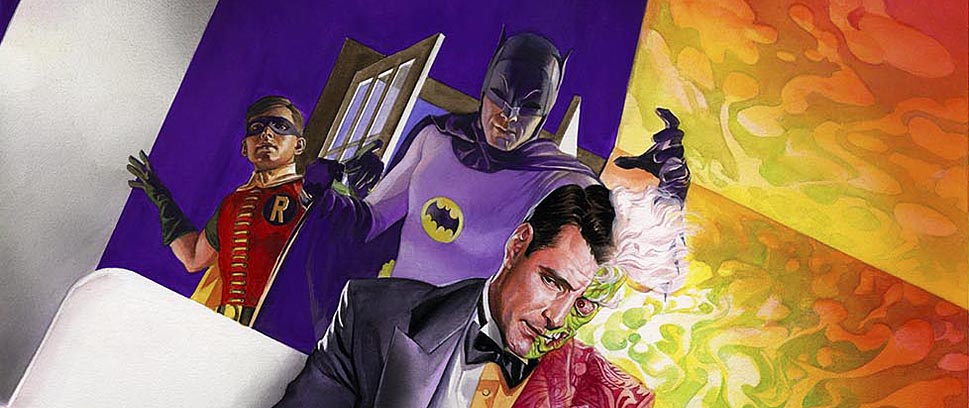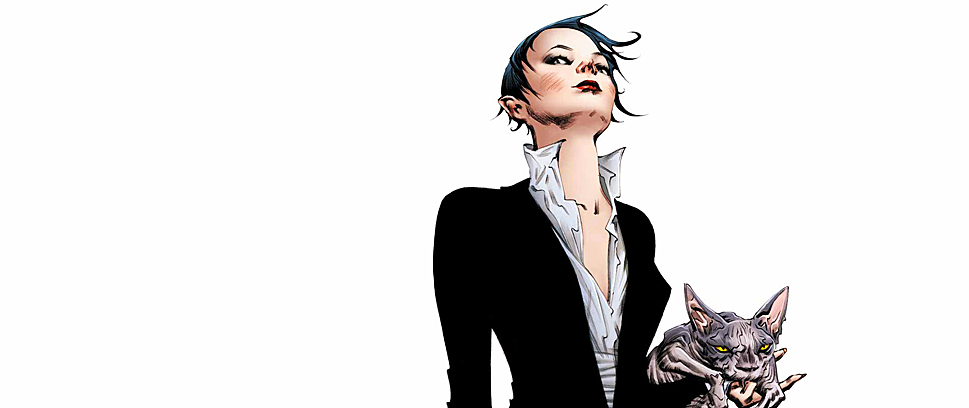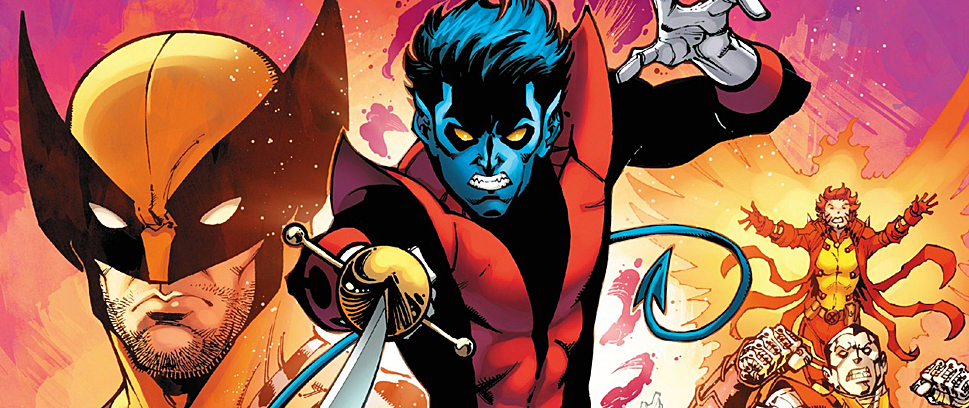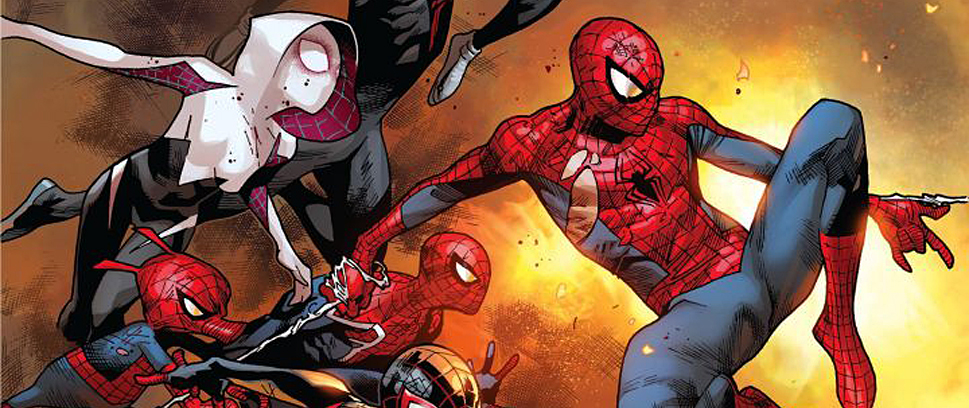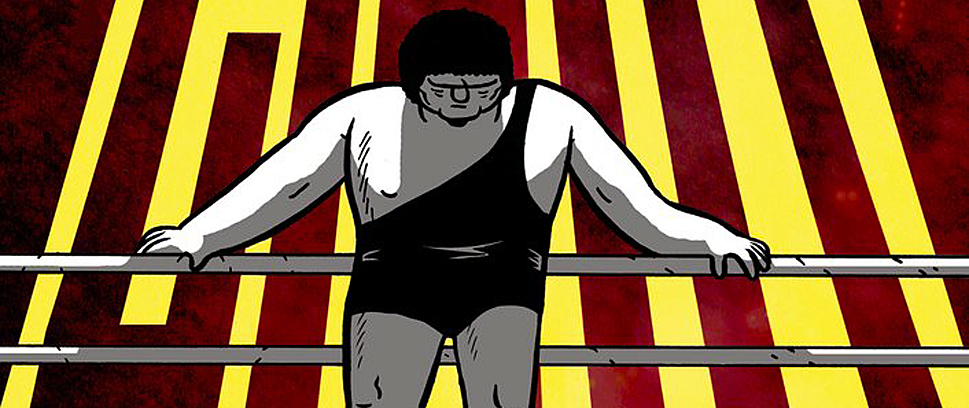
Last Week’s Comics 7/23/2014
Andre the Giant: Life and Legend
(First Second Books – writer: Box Brown; art: Box Brown)
Andre Roussimoff was not a simple man and Andre the Giant: Life and Legend is not a simple story. Cartoonist Box Brown takes the story of a man suffering from acromegaly (his body outgrows his organs and skeleton) who goes on to become one of the most famous professional wrestlers of all time. Brown’s work here is staggeringly graceful – a perfect blend of design and storytelling that dares to fit Andre Roussimoff’s story into 240 pages. Andre’s life and world were complex, and Brown captures not just the spectacle of the man but the man himself in what had to be a monumental amount of research.
 One of the reasons this book was such a colossal task is that in professional wrestling, as Brown states in his introduction, “it’s hard to believe anything a wrestler says.” He goes on to write, “the idea that wrestlers would exaggerate to make themselves look better, and make their friends look better, make their actual enemies look worse, even in so-called ‘real’ shoot interviews, is not unheard of.” Heck, anyone who grew up watching WWF and WCW knew that these guys would change allegiances every few months when they were “in story.” As a kid, I didn’t care whether or not it was fake or real. Wrestling was as real to me as Spider-Man and Usagi Yojimbo comics. I enjoyed the stories but never gave much thought to how they were crafted.
One of the reasons this book was such a colossal task is that in professional wrestling, as Brown states in his introduction, “it’s hard to believe anything a wrestler says.” He goes on to write, “the idea that wrestlers would exaggerate to make themselves look better, and make their friends look better, make their actual enemies look worse, even in so-called ‘real’ shoot interviews, is not unheard of.” Heck, anyone who grew up watching WWF and WCW knew that these guys would change allegiances every few months when they were “in story.” As a kid, I didn’t care whether or not it was fake or real. Wrestling was as real to me as Spider-Man and Usagi Yojimbo comics. I enjoyed the stories but never gave much thought to how they were crafted.
Box Brown researched numerous sources to get to the best truth he could find and presents it in this comic. One story involved Andre telling a racist joke that caught the ire of wrestler Allen “Bad News Brown” Coage. It’s a story that Coage, Terry “Hulk Hogan” Bollea and Tom “Dynamite Kid” Billington would tell, and all of their recollections had both subtle and glaring differences. When presenting the scene in the book, Brown went for the one that he gauged would be closest to the truth.
Brown’s storytelling feels like real life. There is a scene in 1977 where Andre is at a hotel. A French-speaking woman catches his eye and, after he makes sure his friend gets to their hotel room in one piece, Andre goes back and winds up having a one-night stand with the woman. In that moment it seems to illustrate life on the road, but it also implies a pattern and foreshadows another tragic layer in his life. The flow isn’t a straight line from A to B, it’s much more complex. The story moves on from Andre’s sexual escapade to the Bad News Brown story. Afterwards, it jumps to 1980, where Andre is speaking on the phone.
The whole heartbreaking sequence takes place on two pages. On the first page, Andre sits uncomfortably in a hotel room chair. He’s talking on the phone. All he says is, “I couldn’t be any kind of father to your baby…” It’s a splash page. The second page is made up of two panels. In one, Andre hangs up the phone and then sighs in the next panel.
One of the tragedies of Andre’s life is that once he left France, all he had was wrestling. It afforded him a great many of life’s pleasures and his respect for the work was unparalleled, but he never had anyone to go home to on his North Carolina ranch. In Andre’s eyes, the touring life wasn’t the life of a family man and all Andre did was tour.
First Second books published Andre the Giant: Life and Legend in May. But I just read the book and desperately needed to write about it, as the story grabbed me more than any other comic I read this past week. It should be available at finer comic book stores (or, you know, Amazon). I implore you to pick it up.
———
Uncanny X-Men #23
 (Marvel – writer: Brian Michael Bendis; art: Kris Anka)
(Marvel – writer: Brian Michael Bendis; art: Kris Anka)
I’ve been rushing to catch up with the intertwining Uncanny X-Men and All-New X-Men books to be able to read Uncanny #23 in time. I accidentally saw a solicitation a few months ago that advertised “The Last Will and Testament of Charles Xavier.” I was meandering through X-trades as they were released, but thinking about what might be coming with this issue forced me to play catch-up, and fast.
Brian Michael Bendis’ time-displaced original X-Men is a fresh take on the gang. I thought that it would be a short arc, but it keeps going, weaving through two books over almost three years – extended storytelling not seen since Grant Morrison’s run. At this point, readers can’t really jump into Uncanny X-Men or All-New X-Men at any given issue. There are some pauses between individual arcs, but the overall plot of the jacked-up space-time continuum is the story, and readers really need to start at the beginning.
I was hesitant about committing to another regular title or two each month, as Marvel almost constantly has universe-altering crossovers (I bet that if someone reads this review five years from now, Marvel will be in the middle of a universe-altering crossover). Marvel is a little less kind than DC in this respect, as with DC, one does not have to buy every single chapter of a crossover to follow the story.
My thoughts are a little jumbled on account of my X-cramming, but Uncanny X-Men #23 is just a teaser for what’s coming in issue 24: Charles Xavier’s will. The cover, originally advertised as looking like just a black leather-bound book, is marred by the “Original Sin” plug. Kris Anka steps in for series regular Chris Bachalo on art, and while keeping the tone and color palette similar, Anka does create some interesting visuals (like Dazzler’s bathroom scene; I’ll stop there lest I spoil anything.)
I don’t foresee things changing much for our time-lost X-Men in the Uncanny X-Men world, as the story still has legs. But if this tale were to wrap up as the result of Xavier’s will reading, then I say good for Bendis knowing when to go out while things are hot.
———
Silver Surfer #4
 (Marvel – writer: Dan Slott; art: Michael Allred)
(Marvel – writer: Dan Slott; art: Michael Allred)
Silver Surfer #4 explores one of the Silver Surfer/Norrin Radd’s most complicated relationships. No, not with Galactus, or Shalla-Bal, but with Earth itself. After the many things the Silver Surfer has experienced during his godlike existence, his decade or so as a prisoner on Earth was what shaped him the most. While it gave him a reason to admire and love the Earth’s population it has also led him to cautiously avoid ever being imprisoned here again. As he crankily explains to his earthling companion, Dawn Greenwood, early on in this issue: “With my cosmic senses I had ample time to learn and know everything your world has to offer. Everything.”
Of course, we know his stubborn outlook will change, and Dawn Greenwood is the key to this. What we don’t know yet is why monsters are running wild on Earth, especially in Dawn’s hometown of Anchor Bay. This problem is so pronounced that even Doctor Strange and the Hulk are getting in on this case, after fighting off a squad of Universal Studios-like monsters at the Amity Rest Home in Jersey City at the beginning of the issue.
Much like in the previous three issues of this Silver Surfer run, Dan Slott provides plenty of fun things for Michael Allred to draw. Instead of a space station resort full of aliens, it’s a beach town full of monsters. This series is operating on a number of levels that are the M.O. of both Slott and the Allred, while maintaining the overall arc that is the saga of the Silver Surfer.
There’s still a Doctor Who vibe to these stories, but this is about Norrin Radd and the Silver Surfer. Just seeing the Surfer “power down” to Norrin Radd in one scene so that he may join Dawn and her family for dinner seems like such a leap forward in character development, especially when he eats too much soup and ponders, “Why haven’t I done this more often?” For a character who has seen and experienced more than almost every living thing in the universe combined, he’s still dumbstruck by the little things we take for granted.
If there was one thing I was scratching my head about in this issue, it was the guest appearance of the Guardians of the Galaxy, as advertised on the cover. I know they have a movie coming out soon and I thought their interaction with Dawn and the Surfer was amusing, but they basically played the role of customs officers and let them go on their way. I could be wrong and they’ll play a bigger role in this story arc, but it just seemed weird that they don’t have better things to do. It’s also a frustrating reminder that it will be a long time before we see them interacting onscreen in a movie together. C’mon Fox, just give up those film rights to Disney and Marvel Studios already!
Silver Surfer #4 is good fun that continues to be the much-needed breath of fresh air that the character needs. While sometimes the humor can be jarring, it never feels out of character. After watching my fair share of Doctor Who and reading enough Silver Surfer, I know that there will always be seriousness to balance out the levity, and by the end of this issue we see that the Surfer’s nightmare is realized. What the nature and magnitude of this nightmare is has yet to be determined.
———
She-Hulk #6
 (Marvel – writer: Charles Soule; art: Ron Wimberly)
(Marvel – writer: Charles Soule; art: Ron Wimberly)
I can’t believe it’s taken me this long to get around to the current run of She-Hulk. Always a character full of potential in regards to her relationship to the rest of the Marvel Universe as both superhero and super lawyer, Jennifer Walters has undergone many transformations and team affiliations over the years. John Byrne and Dan Slott have both had memorable runs with the character in the past, and now Charles Soule is shaping up to do the same. His current Marvel NOW! run of She-Hulk has been witty and brisk, while also exploring the various corners of the Marvel Universe and checking in with a variety of Marvel characters – from A- to D-grade. Now if only the art could keep up.
For the first four issues of this series, Javier Pulido was handling the art chores and doing an excellent job. While slightly off in an intentional way, it complimented the slightly off characters as well. Ron Wimberly’s artwork, unfortunately, just feels off. Backgrounds are erratic when they exist, proportion and perspective are wonky to the point where I had to question whether Tigra and Wyatt Wingfoot had Mr. Fantastic stretchy powers, and even She-Hulk’s hair is inconsistent in length and style from panel to panel. Something’s wrong when, in the last couple of issues, I’m rereading pages three or four times to understand the visual narrative.
I hate to be so negative about the art, because otherwise I enjoyed everything else about this issue, including the consistently sensational cover artwork from Kevin Wada. From the mysterious “Blue File,” to the She-Hulk and Nightwatch team-up against a bunch of demons, there was a lot fun to be had. Soule is great at balancing the legal talk (he himself is lawyer) with a good old-fashioned donnybrook that wouldn’t be out of place in a ’70s or ’80s Marvel comic. Not only that but he develops little mysteries like the supernatural nature of assistant Angie and her pet monkey Hei Hei’s relationship. Soule does such a great job with keeping She-Hulk herself as three dimensional as possible that it almost transcends the visual blemishes. Almost.
Maybe it’s just a temporary thing and Wimberly will improve, or maybe Javier Pulido will be brought back. Or maybe it’s just me and I will get used to Wimberly’s style. Either way, here’s hoping for at least some consistency in the art department, because Charles Soule is taking She-Hulk in an excellent direction otherwise. Smart, funny and full of surprises, She-Hulk shines and takes us to corners of the Marvel Universe that we rarely visit. The book also shows us that problems don’t always need to be resolved with fists; although, yes – sometimes fists happen.
———
Robin Rises: Omega #1
 (DC Comics – writer: Peter J. Tomasi; art: Andy Kubert)
(DC Comics – writer: Peter J. Tomasi; art: Andy Kubert)
Cheesy title aside, Robin Rises: Omega is a much-hyped miniseries that teases the possibility that Damian Wayne, Bruce’s violent, sensitive, pint-sized angst-ridden ninja of a son, might come back from the dead. Damian was killed last April (just a month or so in the characters’ continuity), by his own growth-accelerated clone, on his mother’s orders (comic books!) in Batman, Incorporated #8.
Robin Rises: Omega begins with a little recap that traces Batman’s history with the al-Ghul family, from his first fight with Ra’s to his love affair with Ra’s’ daughter Talia, and the birth of Bruce and Talia’s son, Damian and Damian’s violent upbringing before he went to live with Bruce at age 10 and became the next Robin. Not much new information here, except for one critical detail: Bruce and Talia’s sexual relationship that produced Damian is once again depicted as consensual (writer Grant Morrison had retconned it to be Talia raping Bruce). Writer Peter J. Tomasi is usually exceptional among New 52 writers at keeping continuity straight, so you know he is intentionally re-retconning it as consensual, which is only a good thing.
The art on these recap pages has a faded look, as if it’s got a soft filter on it. This gives it a misty, nostalgic look that, paradoxically, gives the panels a fresh look even as they recreate, sometimes almost precisely, panels from previous issues of Batman and Robin, Batman, Incorporated and the “Death of the Family” arc.
Next we pick up where Batman and Robin #32 left off, with Batman, Ra’s al-Ghul and Frankenstein facing the so-called Glorious Godfrey of Apokolips and a squad of parademons, who appeared out of nowhere at the end of that issue. Apparently Godfrey is here because there’s something called a “chaos shard” hidden in Damian’s coffin, which, yes, has been lying on the snow between the combatants the entire time, as has Talia’s.
A fight breaks out because of course it does, with Ra’s and Batman grudgingly teaming up, as mortal enemies do, etc. etc. Batman, Ra’s and Frankenstein hold their own very well, considering parademons almost destroyed all of Earth-2 (a parallel Earth to the Earth-Prime of the New 52). But after a few pages, Frankenstein takes a tumble into a frigid lake, and Ra’s and Talia’s coffin eventually plummet over a cliff together. But Batman still has time to grab the Chaos Shard and have a strange vision – or perhaps a memory? – concerning Damian.
This moment, brief as it was, was the highlight of the issue, as it sets up the actual plot of Robin Rises: Omega. But it’s quickly over, and the rest of the issue concerns the Justice League intervening in the parademon fight and several pages of characters yelling at each other. Frankenstein also comes back, and Batman acknowledges that Ra’s is almost certainly not dead either, which drains the earlier half of the book of whatever tension it had. Between these scenes and the earlier fight scene, it kind of feels like the creators were trying to fill space in this extra-long book.
So while Robin Rises: Omega didn’t thrill me, it’s obviously too soon to pass judgment. I’m excited by the possibility of a crossover with Earth-2, and, though I love Damian as a character, I’m intrigued by the possibility of an all-new Robin. But I’m wary of a resurrection plot, which would simply turn Damian into Jason Todd 2.0. And I dread the idea of a zombie Damian. But I guess we’ll just have to wait and see.
———
Grayson #1 Released July 9
 (DC – writer: Tim Seely; art: Mikel Janin)
(DC – writer: Tim Seely; art: Mikel Janin)
Earlier this month, DC Comics’ website featured a full-page advertisement for its new Grayson comic. “You think you know Nightwing… you don’t know Dick.” Pun notwithstanding, the slogan got me thinking: does DC comics really think I don’t know Dick Grayson? Who among DC Comics’ fan base needs to be convinced to read a comic all about Dick Grayson? I thought about it, and I formed the hypothesis that DC Comics’ Grayson marketing campaign is primarily targeted at men (no real surprises there), but in this case, it’s because, for the most part, DC Comics’ women fans (and we are legion) DO already know Dick. Pun notwithstanding.
DC Comics has been talking about making its fans like Dick for a while now. Former Nightwing writer Kyle Higgins said in several interviews that one of his goals with the book was to bring Dick out of Batman’s shadow, and during his run Dick even moved from Gotham to Chicago in an effort to distance him from the Bat. I was kind of surprised. “Who doesn’t know Dick Grayson?” I thought.
Dick Grayson has always been, in general, more popular with women fans than with men, and no, it’s not just because he’s hot (though he is). It’s because he’s like Batman, but with an actual personality (I love you Bats but you know it’s true). He’s sensitive and vulnerable, whether he’s being rescued by Batman circa the 1940s or struggling to maintain a work-life balance in modern comics. He’s not an arrogant hypermacho power fantasy. He has strong male and female friendships (or he used to; in the New 52 not so much) and he dates strong ladies. What’s more, he is often drawn in a way that aligns with the female gaze instead of the male, an extreme rarity in mainstream comics. Many of these traits have led some comic book fans – usually men (though #notallmen) – to mock him.
So my fear going into Grayson #1 was that DC Comics would use the book to reinscribe Dick Grayson as the sort of hypermasculine comic book hero that I often find boring at best and highly problematic at worst. However, I am very happy to say that my fears were not realized: Grayson #1 was pretty great.
That isn’t to say Dick Grayson is a feminist icon in Grayson, by any means. He’s got a considerable James Bond vibe going on (even though most or all of it is a performance), and the seemingly obligatory sexual tension with fellow spy and femme fatale Helena Bertinelli has already begun. Artist Mikel Janin could also work on the butt shots. There’s a reason Dick Grayson’s ass has an entire Tumblr devoted to it, that’s all I’m saying.
On the subject of art, the much-publicized cover by Andrew Robinson didn’t really do it for me. Dick Grayson looks like a cross between Jay Leno and Johnny Depp, and the perspective is warped to exaggerate Grayson’s controversial gun. But inside the book, Janin completely kills it. His lines are clean, and colorist Jeromy Cox brings a vibrancy rarely seen in Batman books. Janin also has fun with panel borders, using diagonal lines and even wavy lines to give the book a pulpy, slightly retro feel that nevertheless doesn’t distract from the action contained within them. But best of all is Janin’s Dick Grayson himself. Movement is critical to Dick Grayson as a character, both in his combat style and his the way he expresses himself, and Janin’s Grayson moves fluidly across the page.
Dick’s personality also does some pretty serious acrobatics throughout Grayson #1: we see snarky spy, douchey tourist (a disguise), even a glimpse of Nightwing’s classic jaunty sarcasm in the fight with Midnighter. But then there’s the cold, even manipulative Dick, who bends his target to his will, making for one of the issue’s most striking and disturbing moments. But I liked it – Dick is alone and deep under cover behind enemy lines; I want to see him change and grow as he struggles to adjust. I think I’ve already made my take on Dick Grayson’s character pretty clear, but from where I’m standing writer Tim Seely did an excellent job of finding Dick’s voice while also pushing the character into new territory.
Seely also shows himself highly proficient in that skill so essential to writing good first issues: the subtle sprinkling of new mysteries that entice the reader to keep reading. The trick is to not be so heavy-handed that the issue is unintelligible, and Seely did it: Grayson #1 reads like a fun spy romp, but it also leaves me wanting to know more about Helena Bertinelli and Midnighter, two great characters of whom I’m excited to see more. And about Dick’s new “Hypnos” power, I know little more than the fact that it’s not a Pokémon implanted in his face. Probably.
I’ve reviewed several first issues for this column, and I always find myself giving them a lot of latitude. “This was pretty good, and I’m optimistic it will probably get better!” With Grayson #1, however, I’ve found myself thinking the opposite: “This was pretty good, but I’m pessimistic it might get worse!” This is not at all a fair attitude for me to have, but the reason I find myself thinking this way is because, despite DC Comics’ assurances otherwise, I do know Dick, and I feel protective of him.
To close, let me share my favorite moment in Grayson #1. In Dick’s secret transmission to Batman about Spyral, he refers to himself with the code-name “Bird-Watcher.” During my first reading, I wondered why he had chosen that name – did Spyral have a bird theme that I didn’t pick up on? It wasn’t until a few hours later that it suddenly dawned on me: Dick isn’t watching birds. He is the bird – the Robin, the Nightwing – who is watching. That’s the moment that convinced me: Grayson may be written to capture a new demographic of readers, but for long-time Dick Grayson fans, our boy is still a bird at heart.


